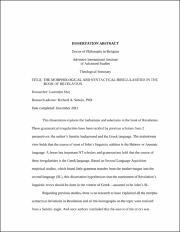The morphological and syntactical irregularities in the Book of Revelation
Abstract
This dissertation explores the barbarisms and solecisms in the book of Revelation. These grammatical irregularities have been tackled by previous scholars from 2 perspectives: the author’s Semitic background and the Greek language. The mainstream view holds that the source of most of John’s linguistic oddities is the Hebrew or Aramaic language. A fewer but important NT scholars and grammarians hold that the source of these irregularities is the Greek language. Based on Second Language Aquisition empirical studies, which found little grammar transfer from the mother tongue into the second language (SL), this dissertation hypothesizes that the assessment of Revelation’s linguistic errors should be done in the context of Greek––assumed to be John’s SL.
Regarding previous studies, there is no research to have explained all the morpho-syntactical deviations in Revelation and all the monographs on the topic were realized from a Semitic angle. And once authors concluded that the source of the errors was
Semitic, they did not consider to evaluate the errors in a Greek framework. This study is meant to fill this gap and looks at the Apocalypse’s language as a SL production. This perspective does not neglect or reject Semitic influence to some degree.
The methodology brought together several disciplines of modern linguistics and NT studies. The first step taken was to observe how the first scribes corrected the text in trying to come to terms with its grammar. The second step was the grammatical analysis realized in a descriptive, synchronic, and diachronic perspective. Here sociolinguistics played an important role, as it advocated the replacement of the notion of “wrong” language with labels such as “different” or “not preferred” language. The third methodological step was the cross-linguistic assessment. Psycholinguistics was of primary importance at this stage as it revealed different aspects from which an irregular construction can be looked at: the mother tongue, the SL, the interlanguage (author’s own language in the making), and language as system and language as performance. The fourth step taken was to look at the morpho-syntactical issues at the discourse level. Pragmatics was informative as it left room for things implied but not written in the text.
A number of important findings resulted from the analysis. From more than 230 grammatical irregularities, less than a quarter of these are actual irregularities to the Greek language. There are very few Semitic transfers and most of the linguistic errors or ambiguities are produced because of John’s less than proficient level of Greek acquisition. Though John was not volitional in his mistakes, he was intentional as he struggled to make sense of his message in Greek with the linguistic knowledge he had. This statement has repercussions in the interpretation of the text, and at times the linguistic errors were significant enough to change the meaning of what John wrote.


